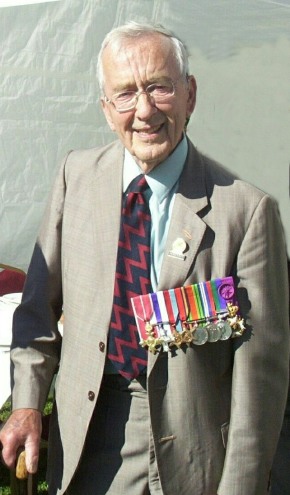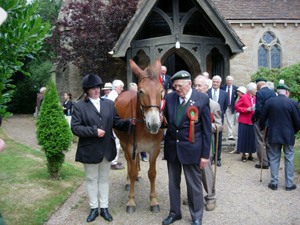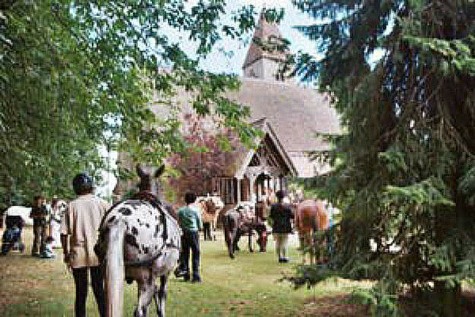
 |
The first is a gentle story
contributed by Colleen Hughes, West Felton local historian. The second is about one man`s love of the
mules who saved many lives in the jungles of Borneo.
DOLLY THE PONY nearly went to war
Dolly lived with John
Henry Jones and his wife Mary Jane, sons Eddie and Lawrence and daughter Doris
(later Hamlett) at Keeper’s Cottage on the Woodhouse Estate.
John Henry was
serving in the trenches in Macedonia when, one Wednesday market day, Mary Jane
went to Oswestry to sell her produce. She left Dolly with the trap at The Bear
Hotel.
When she arrived
back at The Bear, loaded down with shopping, Dolly was missing!
The Army had
requisitioned all the horses and taken them to Park Hall army camp for transportation
abroad.
Highly indignant,
Mary Jane marched all the way to Park Hall to persuade the Army that she
couldn’t manage without Dolly. They finally relented, she walked Dolly back to
The Bear for the trap, then they went home to Keeper’s Cottage where Dolly
lived out the rest of her life.
The Jones family
eventually went to live at Ivy Cottage, Rednal. John Henry returned safely from
the war and continued to work for the Woodhouse Estate for over 50 years.
…………………………..
JOHN KENYON OWED HIS LIFE TO
MULES
Colonel John F. Kenyon was born and grew up at
Pradoe, near West Felton. In 1943 he
joined the Indian Mountain Regiment and was involved in intense fighting in
Burma.
The regiment was to go into the jungle to harry the
Japanese as they retreated north. It was
decided that the staying power and agility of mules, from South America, would
be the best mode of carrying armaments and supplies though the dense jungle
where wheeled vehicles would have been useless.
As the dulcet call of the mule would not be
required when the soldiers were in the dense jungle harrying the Japanese,
blowing bridges and destroying communications,
so the animals were `devoiced` i.e. their vocal cords were removed. Next, the training was to develop a close
relationship between animal and driver through the horrible conditions of the
wet and humid jungle, covering up to 20 miles a day.
When the monsoon started it was hell, elephant
paths became rivers of mud which even the mules found difficult to negotiate. The men were soaking wet for days on end and
plagued by leeches which got into their boots through the lace holes. The temperature in this soggy jungle was 100
– 120 and the men had to take plenty of salt tablets to avoid passing out.
Throughout this nightmare, John Kenyon of leafy
Pradoe in Shropshire developed a lasting affection for mules. One night during close quarter fighting with
the Japs, a mule was badly wounded close to this trench. He got out to dispatch it, then returned to
find that the trench had been destroyed by a shell. A mule had saved his life.
After this particular battle at Arakan, Kenyon`s 7th
Indian Division were flown straight to Kohima without any rest. On operations, the 3.7in pack Howitzer was
transported in eight rapidly assembled mule-borne loads. The ability of the mules to operate in
conditions inaccessible to vehicle-transport guns was a war winning factor.
The war in Burma has the distinction that sickness
played almost a bigger part than deaths or wounds - 25,000 troops fell ill from
malaria, dysentery and diarrhoea over the campaign.
The Battle of
Kohima.
Pouring rain, thick mist and the jungle terrain severely limited observation
but John Kenyon`s coolness, determination, accuracy and prompt action during
nine hours under continuous heavy fire provided invaluable assistance to the
infantry and saved many lives. He was awarded the MC.
Col. John Frederick Kenyon, M.C. died on 15th
October 2006 aged 84.
Animal lovers will be pleased to know that the
mules, left behind with the people in Borneo, soon regained their voices.
In 1944 Kenyon, a lieutenant, was serving with 5 (Bombay) Indian Mountain
Battery, part of 25th Indian Mountain Regiment. On June 12 he was forward
observation officer with a company of the 2nd Battalion, South Lancashire
Regiment, which was mounting an attack near the village of Jessami, east of
Kohima.
Advancing in thick mist to within 40 yards of the Japanese, they suddenly
came under heavy machine-gun, rifle and grenade-discharger fire from enemy
entrenched in well-protected bunkers. Kenyon quickly brought down neutralising
fire, which allowed the leading infantry to consolidate without further
casualties.
He then called down close supporting fire from two mountain batteries, which
allowed his men to get within 20 yards of the bunkers before and led directly
to their capture.
Pouring rain, thick mist and the jungle terrain severely limited observation
but his coolness, determination, accuracy and prompt action during nine hours
under continuous heavy fire provided invaluable assistance to the infantry and
saved many lives. He was awarded the Military Cross.
 |
 |
 |
| Co. John F. Kenyon of Pradoe | Mules at Pradoe church in memory of the Burma Campaign 2006 | Mules gather at Pradoe church in memory of the Burma Campaign |